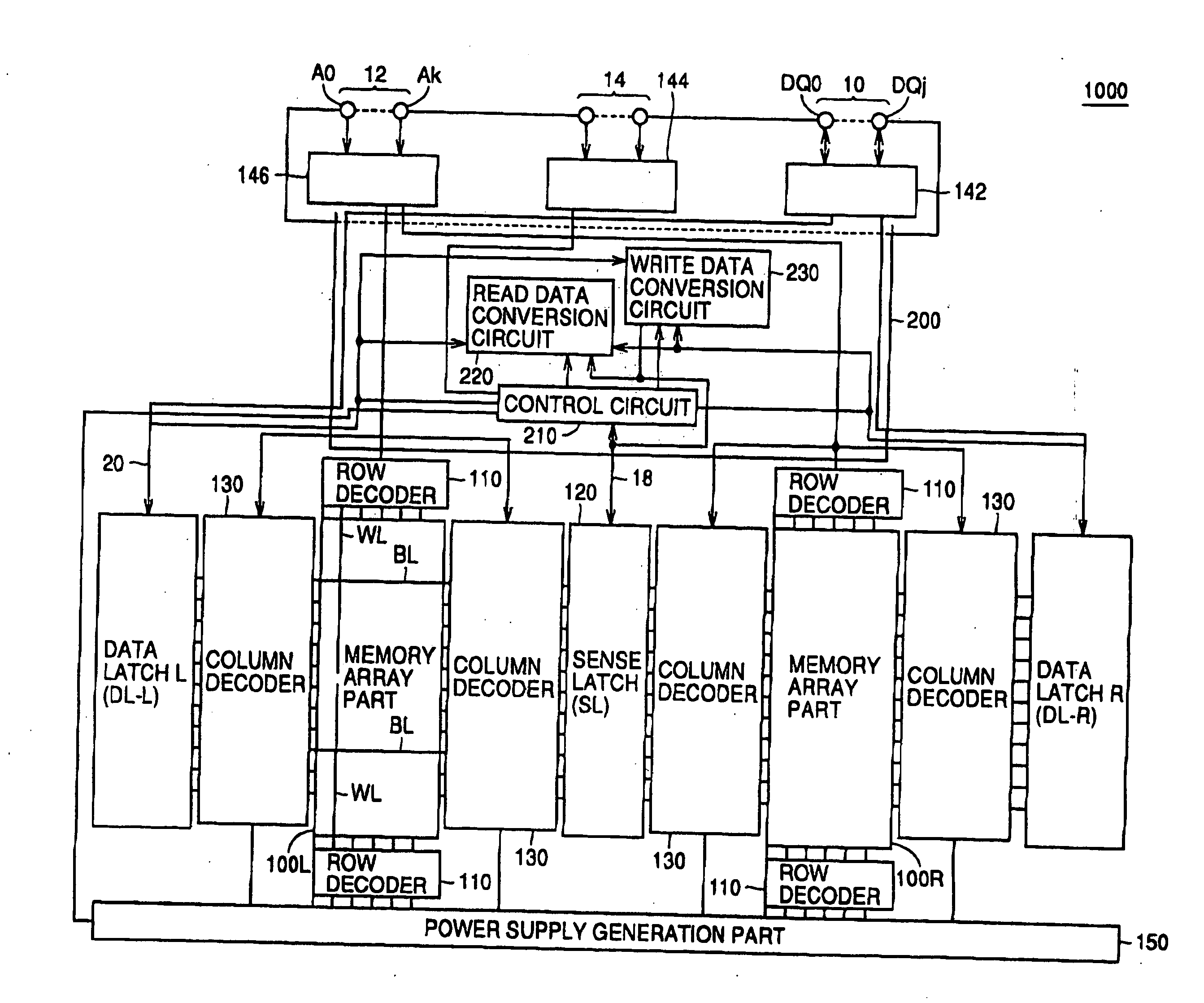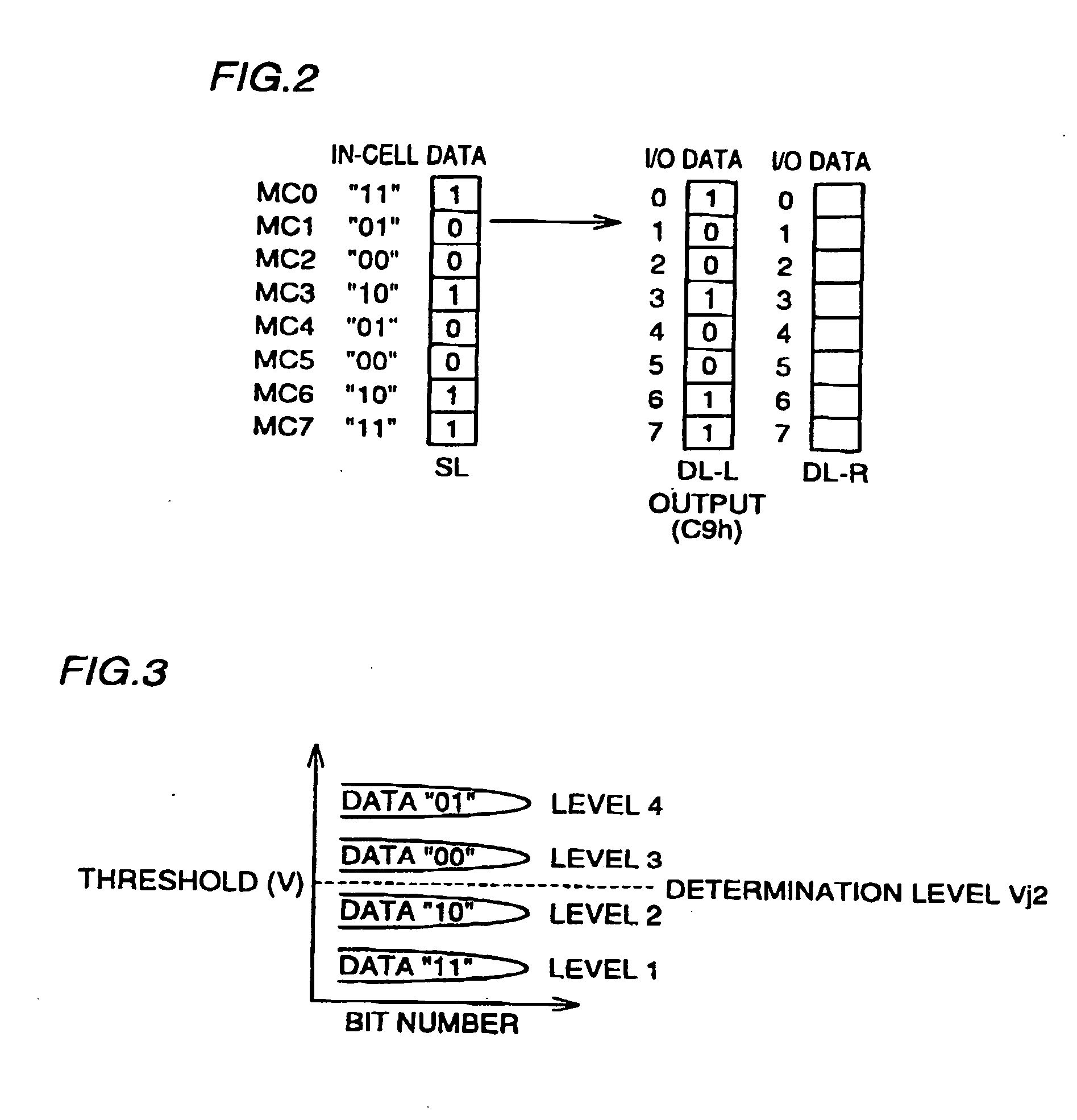Multilevel storage nonvolatile semiconductor memory device enabling high-speed data reading and high-speed data writing
a nonvolatile semiconductor and memory device technology, applied in the direction of digital storage, instruments, computing, etc., can solve the problems of serious speed degradation, and achieve the effect of reducing the data input tim
- Summary
- Abstract
- Description
- Claims
- Application Information
AI Technical Summary
Benefits of technology
Problems solved by technology
Method used
Image
Examples
first embodiment
[0204]FIG. 1 is a schematic block diagram showing the structure of a flash memory 1000 forming a nonvolatile semiconductor memory device according to a first embodiment of the present invention.
[0205] A memory cell array 100 has a number of memory cells including floating gates and control gates. Also in FIG. 1, the memory cell array 100 is divided into two memory cell blocks 100R and 100L.
[0206] The control gates, drains and sources of the memory cells are connected to word lines WL, bit lines BL and source lines SCL (not shown) respectively.
[0207]FIG. 1 representatively shows two word lines WL and two bit lines BL respectively.
[0208] Row decoders 110 selectively drive the word lines WL on the basis of address signals A0 to Ak externally supplied through an address signal input terminal group 12 and an address buffer 146. A sense latch circuit 120 is provided on single ends of the bit lines BL. The bit lines BL are selected on the basis of selection signals output from column d...
second embodiment
[0279]FIGS. 16A and 16B illustrate the concept of a system of switching connection between a sense latch circuit 120 and bit lines BL1 and BL2 of a flash memory according to a second embodiment of the present invention. Referring to FIG. 16A, the bit line BL1 is connected to a sense latch SL corresponding to 1-bit data in the sense latch circuit 120. Referring to FIG. 16B, the bit line BL2 is connected to the aforementioned sense latch SL.
[0280] The flash memory according to the second embodiment is basically similar in structure to the flash memory 1000 according to the first embodiment except the structure shown in FIGS. 16A and 16B and a control operation of a control circuit 210.
[0281] When the sense latch circuit 120 captures data from the bit lines in a divided manner as to adjacent memory cells while a single word line WL is selected, first to third processing steps can be dividedly performed in parallel with each other every data reading from the memory cells due to the st...
third embodiment
[0331] An exemplary data write operation in the structure of the flash memory 1000 according to the first embodiment is now described as a third embodiment of the present invention.
[0332] FIGS. 31 to 36, illustrating operations of the third embodiment of the present invention, are conceptual diagrams showing data held in data latches DL-L and DL-R and a sense latch SL as well as thresholds of memory cells and determination levels in writing in first to third processing steps of a write operation.
[0333]FIG. 31 shows data held in the respective latches in the first processing step of the write operation, and FIG. 32 shows thresholds of the memory cells and determination levels in the first processing step of the write operation.
[0334]FIG. 33 shows data held in the respective latches in the second processing step of the write operation, and FIG. 34 shows thresholds of the memory cells and determination levels in the second processing step of the write operation.
[0335]FIG. 35 shows ...
PUM
 Login to View More
Login to View More Abstract
Description
Claims
Application Information
 Login to View More
Login to View More - R&D
- Intellectual Property
- Life Sciences
- Materials
- Tech Scout
- Unparalleled Data Quality
- Higher Quality Content
- 60% Fewer Hallucinations
Browse by: Latest US Patents, China's latest patents, Technical Efficacy Thesaurus, Application Domain, Technology Topic, Popular Technical Reports.
© 2025 PatSnap. All rights reserved.Legal|Privacy policy|Modern Slavery Act Transparency Statement|Sitemap|About US| Contact US: help@patsnap.com



